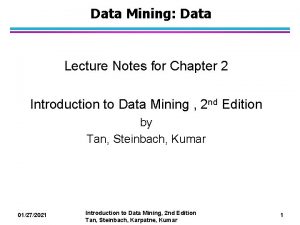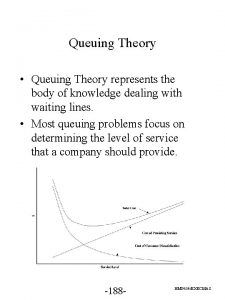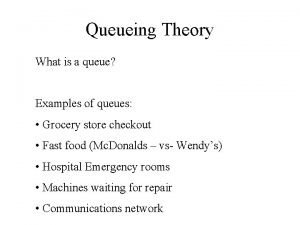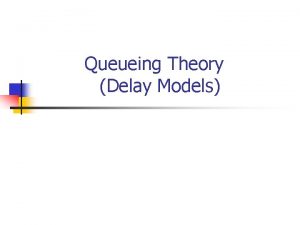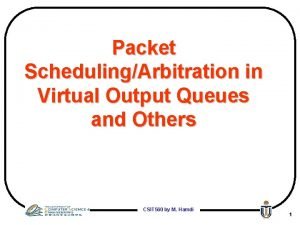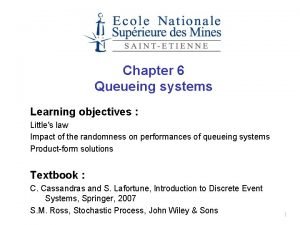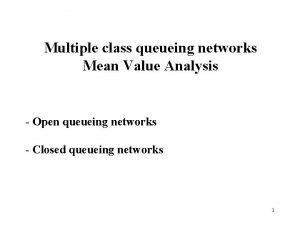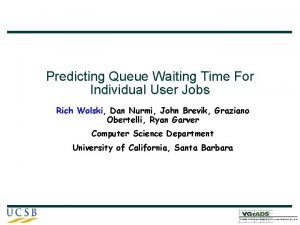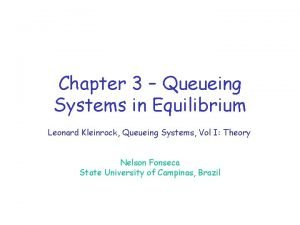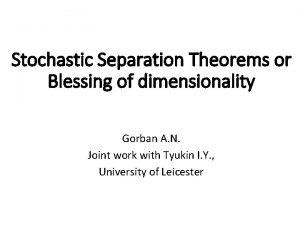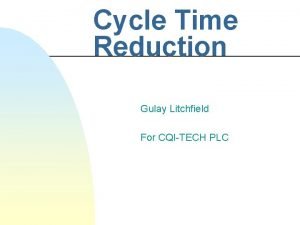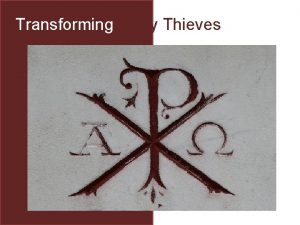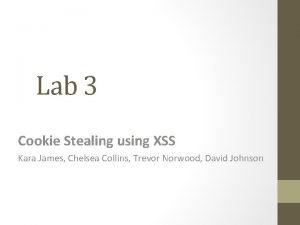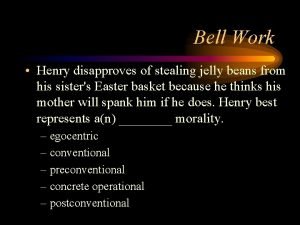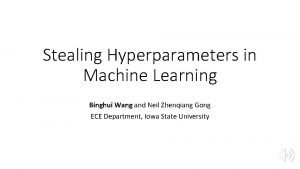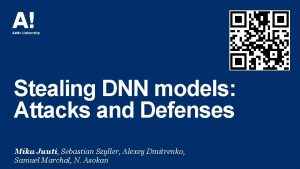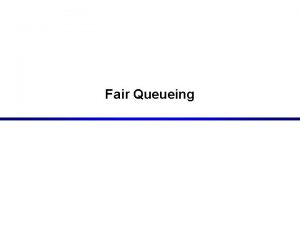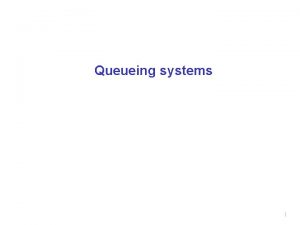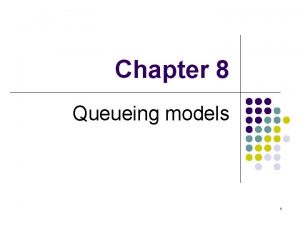Dimensionality Reduction for Analyzing Cycle Stealing Priority Queueing



![Cycle Stealing Problem l. B jobs/sec [Sigmetrics 03, Perf. Eval. 05] l. D jobs/sec Cycle Stealing Problem l. B jobs/sec [Sigmetrics 03, Perf. Eval. 05] l. D jobs/sec](https://slidetodoc.com/presentation_image/412efd88d3e7965f6bad1b56a3d650ba/image-4.jpg)











![Some interesting questions Q: Exactly how does cycle stealing affect beneficiary and donor? E[TB] Some interesting questions Q: Exactly how does cycle stealing affect beneficiary and donor? E[TB]](https://slidetodoc.com/presentation_image/412efd88d3e7965f6bad1b56a3d650ba/image-16.jpg)

![Some interesting questions Q: How should we set NBth? E[TB] A: Want NBth high, Some interesting questions Q: How should we set NBth? E[TB] A: Want NBth high,](https://slidetodoc.com/presentation_image/412efd88d3e7965f6bad1b56a3d650ba/image-18.jpg)
![Server farm application [SPAA 03, ICDCS 03] Size-based task assignment Shorts only. Longs only. Server farm application [SPAA 03, ICDCS 03] Size-based task assignment Shorts only. Longs only.](https://slidetodoc.com/presentation_image/412efd88d3e7965f6bad1b56a3d650ba/image-19.jpg)






![Priority Scheduling [QUESTA 05, Perf. Eval. 06] M/PH/k with priority classes H L L Priority Scheduling [QUESTA 05, Perf. Eval. 06] M/PH/k with priority classes H L L](https://slidetodoc.com/presentation_image/412efd88d3e7965f6bad1b56a3d650ba/image-26.jpg)














- Slides: 40

Dimensionality Reduction for Analyzing Cycle Stealing, Priority Queueing, Threshold Policies, and more … Mor Harchol-Balter Computer Science Dept. Carnegie Mellon University 1

Many examples multiserver sharing FIFO S L H L MH H Common Problem: 2 D-infinite Markov chain 2

Dimensionality Reduction for Markov Chains — — Approximate technique + Provides first accurate performance numbers for many common problems. Taka Osogami 03] [Sigmetrics Problem-dependent. [SPAA 03] + Very fast (less than 1 sec). Doesn’t always apply. Adam Wierman [ICDCS 03] Alan Scheller-Wolf [Tools 03 a, 03 b] [Allerton+04]< 1% error typically, and can improve. Mark Squillante [Perf. Eval 05] Li[QUESTA Zhang 05] + Models any job sizes, and any loads. [Perf. Eval 06 a] [Perf. Eval 06 b] [Mgmt Science 07] thresholds and switching costs + Adding is often easy. 3
![Cycle Stealing Problem l B jobssec Sigmetrics 03 Perf Eval 05 l D jobssec Cycle Stealing Problem l. B jobs/sec [Sigmetrics 03, Perf. Eval. 05] l. D jobs/sec](https://slidetodoc.com/presentation_image/412efd88d3e7965f6bad1b56a3d650ba/image-4.jpg)
Cycle Stealing Problem l. B jobs/sec [Sigmetrics 03, Perf. Eval. 05] l. D jobs/sec Load r. B Load r. D Betty the beneficiary Dan the donor 4

Cycle Stealing Problem l. B jobs/sec l. D jobs/sec Load r. B Load r. D switch When donor is idle, donor helps beneficiary. 5

Cycle Stealing Problem l. B jobs/sec l. D jobs/sec Load r. B Load r. D switch back When new donor job arrives, donor switches back to donor queue. 6

Generalized Cycle Stealing l. D jobs/sec l. B jobs/sec Load r. B Load r. D time KSW NBthresh Only switch if Betty has NBthresh jobs queued. time KBA NDthresh Only switch back if Dan has NDthresh jobs queued. 7

Cycle Stealing Problem l. B jobs/sec Load r. B l. D jobs/sec Load r. D What is Betty’s/Dan’s mean response time? 8

What’s so hard? l. B 0 B, 0 D l D m. D 0 B, 1 D l D m. D 0 B, 2 D l D m. B l. B 1 B, 0 D l D m. D 1 B, 1 D l D m. D 1 B, 2 D l D m. D 2 m. B l. B 2 B, 0 D l D m. D 2 B, 1 D l D m. D 2 B, 2 D 2 m. B l. B m. B l D m. D Even simplest-case chain grows infinitely in 2 D. 9

Prior work: cycle stealing & coupled-processor Truncate the chain Exponential job sizes (80’s) General Job sizes (80, 90, 00’s) Green Stanford Grassman Rao Posner Convert to Riemann-Hilbert problem Convert to Wiener-Hopf boundary problem Very complex integrals. Fayolle, Iasnogorodski, Konheim, Meilijson, Melkman. . . Very complex integrals for WORKLOAD. No numbers. Cohen, Boxma, Borst, Uitert, Jelenkovic. . . Tail Asymp or Heavy traff. Bob Foley Mc. Donald Mike Harrison Boxma Borst van Uitert Williams 10

Dimensionality Reduction Key idea: 2 D-infinite chain VERY HARD 1 D-infinite chain EASY 11

What’s so hard? l. B 0 B, 0 D l D m. D 0 B, 1 D l D m. D 0 B, 2 D l D m. B l. B 1 B, 0 D l D m. D 1 B, 1 D l D m. D 1 B, 2 D l D m. D 2 m. B l. B 2 B, 0 D l D m. D 2 B, 1 D l D m. D 2 B, 2 D 2 m. B l. B m. B l D m. D Even simplest-case chain grows infinitely in 2 D. 12

Solution l. B Cooperating servers 0 B, 0 D l. D Working independently m. B BD l. B 0 B, 1+D m. B l. B 1 B, 0 D l. D BD 1 B, 1+D 2 m. B l. B 2 B, 0 D l. B m. B BD 2 B, 1+D 2 m. B l. B m. B New type of transition. Donor Busy period: BD 1 D-infinite chain! 13

Solution Cooperating servers Working independently 0 B, 0 D l. D 0 B, 1+D l. B 1 B, 0 D m. B l. B 2 m. B 2 B, 0 D l. B l. D m. B l. B 2 m. B l. B m. B 1 B, 1+D m. B BD = g a b m. B 2 B, 1+D l. B m. B Approximation, but can be made as close to exact as desired. [Tools 03 a, Tools 03 b] 14

Markov chain is easy to generalize • Generalize service distribution • Generalize to switching times • Generalize to include thresholds Load r. B l. B jobs/sec l. D jobs/sec time NBthresh time KSW KBA Load r. D NDthresh 15
![Some interesting questions Q Exactly how does cycle stealing affect beneficiary and donor ETB Some interesting questions Q: Exactly how does cycle stealing affect beneficiary and donor? E[TB]](https://slidetodoc.com/presentation_image/412efd88d3e7965f6bad1b56a3d650ba/image-16.jpg)
Some interesting questions Q: Exactly how does cycle stealing affect beneficiary and donor? E[TB] orig cs E[TD] cs orig r. B 16

Some interesting questions Q: How does donor job size variability affect benef. resp. time? A: Hardly, for r. B < 1 ! E[TB] C 2=50 C 2=8 Exp r. B 17
![Some interesting questions Q How should we set NBth ETB A Want NBth high Some interesting questions Q: How should we set NBth? E[TB] A: Want NBth high,](https://slidetodoc.com/presentation_image/412efd88d3e7965f6bad1b56a3d650ba/image-18.jpg)
Some interesting questions Q: How should we set NBth? E[TB] A: Want NBth high, but not big deal. E[TD] Increasing NBth doesn’t hurt benef! Increasing NBth helps donor r. B Q: How should we set NDth? E[TB] r. B A: Want NDth low if r. B<1. Want NDth high if r. B>1. E[TD] Increasing NDth helps benef only in overload! Increasing NDth hurts donor r. B 18
![Server farm application SPAA 03 ICDCS 03 Sizebased task assignment Shorts only Longs only Server farm application [SPAA 03, ICDCS 03] Size-based task assignment Shorts only. Longs only.](https://slidetodoc.com/presentation_image/412efd88d3e7965f6bad1b56a3d650ba/image-19.jpg)
Server farm application [SPAA 03, ICDCS 03] Size-based task assignment Shorts only. Longs only. Q: Can we enhance this further with cycle stealing? 19

Two cycle-stealing enhancements Central-Queue Immediate-Dispatch Shorts only Longs. Short if idle. Longs. Short if no long. No Immediate stealing Dispatch Central Queue 0 0. 5 1 1. 5 20

N-sharing model l. D l. B m. BD Beneficiary (Betty) m. D Donor (Dan) [Allerton 04, PER 05] cycle-stealing: Dan helps Betty with her work when he’s free. But, can do better with more aggressive cycle stealing, (if Dan processes Betty’s jobs faster than his own). Studied by: S. Bell, R. Williams, M. Harrison, M. Lopez, M. Squillante, C. Xia, D. Yao, L. Zhang, R. Schumsky, L. Green, S. Meyn, A. Ahn, D. Stanford, W. Grassman, … 21

Who gets control: man or woman? Help me when I have > TB jobs, or you’re free. TB Beneficiary Side Control TD I’ll help you when I have < TD jobs. Donor Side Control 22

Who gets control: man or woman? Help me when I have > TB jobs, or you’re free. TB Beneficiary Side Control TD I’ll help you when I have < TD jobs. Donor Side Control Answer: Mean response time E[T] lower when woman controls! 23

Which policy is more robust? Help me when I have > TB jobs, or you’re free. TB Beneficiary Side Control TD I’ll help you when I have < TD jobs. Donor Side Control Answer: Donor control helps, but even better is to let Benef. have 2 thresholds, where Donor controls which threshold is used. 24

Mean response time Results: Adaptive Dual Threshold policy TBT =6=6 TB=20 B (opt when (opt) r. D = 0. 6) (opt when r. D=0. 8) ADT: meets both goals. Dan’s load Similar idea suggested by Sean Meyn under finite queues. 25
![Priority Scheduling QUESTA 05 Perf Eval 06 MPHk with priority classes H L L Priority Scheduling [QUESTA 05, Perf. Eval. 06] M/PH/k with priority classes H L L](https://slidetodoc.com/presentation_image/412efd88d3e7965f6bad1b56a3d650ba/image-26.jpg)
Priority Scheduling [QUESTA 05, Perf. Eval. 06] M/PH/k with priority classes H L L MH H Goal: Mean response time per job type. 26

Prior Work: Multi-Server Priority Queues Two job classes, exponential Truncation w/Matrix Analytic or Aggregation Kao and Narayanan, Kapadia, Kazumi, Mitchell, Nishida Ngo and Lee, Leemans, Miller Generating Functions Davis, Kella & Yechiali, Feng, Kawada, Adachi, Kao and Wilson, Gail, Hantler, Taylor Multi-class simple approx. Scaling as Single -server: Buzen and Bondi Aggregation into Two classes: Mitrani and King Nishida Little known for > 2 classes or non-exponential. 27

2 Priority classes is easy via Dimensionality Reduction l. L 0 L, 0 H l. H m. L m. H l. L 1 L, 0 H l. H 2 m. L m. H l. L 0 L, 1 H l. H m. L 2 m BH l. L 0 L, 2+H l. L 2 L, 0 H l. H 2 m. L m. H l. L 1 L, 1 H l. H m. L 2 m BH 1 L, 2+H l. L 2 L, 1 H l. H m. L 2 m BH l. L 2 L, 2+H 28

What about 3 classes H, M, L? • Can get H and M response times from this chain: • Obvious Idea: Combine H and M into single class HM. L’s are second class. 0, 0 1, 0 2, 0 0, 1 1, 1 2, 1 0, 2+ 1, 2+ 2, 2+ • Need to be careful: Duration of HM busy period depends on who started it: H&H, H&M, or M&M. Must differentiate. 29

Extensions q Recursive Dimensionality Reduction extends to any number of classes and servers. q Generalize service distribution. q Simple representation allows us to derive not just mean response time, but all moments of response time. 30

Mean response time Results: 4 priority classes M/M/2 with 4 classes % error in delay 31

Effect of Variability M/G/1 L H C 2 H Mean response time M/G/2 L H C 2 H 32

Effect of more servers Mean response time M/G/k with 2 priority classes 1 server 2 servers 4 servers 8 servers C 2 H 33

Optimal number of servers (2 classes with same mean) C 2 H r 34

Optimal number of servers Smart Prioritization (Low priority jobs BIGGER) C 2 H Stupid Prioritization (Low priority jobs SMALLER) C 2 H r r 35

Lessons learned on priorities in multiserver Multiserver priority queue performance is very different from single server. Performance depends on many factors: q q Variability of job size Load Number of servers Stupid vs. Smart prioritization 36

There are many other examples of problems analyzable via Dimensionality Reduction … 2 Dinfinite chain 1 Dinfinite chain Open problem: Proving the approximation 37

FIFO S L THANK YOU! H LLH H 38

BACKUP 39

MODIFIED 1 D-chain: cycle stealing with switching costs and NBth = 3 40
 K means dimensionality reduction
K means dimensionality reduction Dimensionality reduction in machine learning
Dimensionality reduction in machine learning Feature reduction in machine learning
Feature reduction in machine learning Dimensionality reduction
Dimensionality reduction Nlp dimensionality reduction
Nlp dimensionality reduction Burman's priority list gives priority to
Burman's priority list gives priority to Priority mail vs priority mail express
Priority mail vs priority mail express Queuing theory formula
Queuing theory formula Queueing theory examples
Queueing theory examples Mm1 queue
Mm1 queue Virtual output queueing
Virtual output queueing Kingman's equation
Kingman's equation Queueing
Queueing Predictive queueing
Predictive queueing Kleinrock queueing systems
Kleinrock queueing systems Dimensionality
Dimensionality Blessing of dimensionality
Blessing of dimensionality Latent semantic mapping
Latent semantic mapping Curse of dimensionality knn
Curse of dimensionality knn Prt handle with care
Prt handle with care Cycle time reduction techniques
Cycle time reduction techniques Stealing god's glory
Stealing god's glory One summer evening by william wordsworth
One summer evening by william wordsworth Volta in the prelude
Volta in the prelude Themes about stealing
Themes about stealing Stealing carol ann duffy
Stealing carol ann duffy Stealing poem
Stealing poem Cross site scripting cookie stealing
Cross site scripting cookie stealing Tudor crime and punishment
Tudor crime and punishment Henry does not steal jelly beans
Henry does not steal jelly beans Henry disapproves of stealing jelly beans
Henry disapproves of stealing jelly beans Examples of incremental plagiarism
Examples of incremental plagiarism Stealing machine learning models via prediction apis
Stealing machine learning models via prediction apis Which is worse, stealing like karl or cheating like bob
Which is worse, stealing like karl or cheating like bob Stealing machine learning models via prediction apis
Stealing machine learning models via prediction apis Stealing hyperparameters in machine learning
Stealing hyperparameters in machine learning Model stealing attacks
Model stealing attacks Netcat
Netcat Iso 22301 utbildning
Iso 22301 utbildning Novell typiska drag
Novell typiska drag Nationell inriktning för artificiell intelligens
Nationell inriktning för artificiell intelligens



